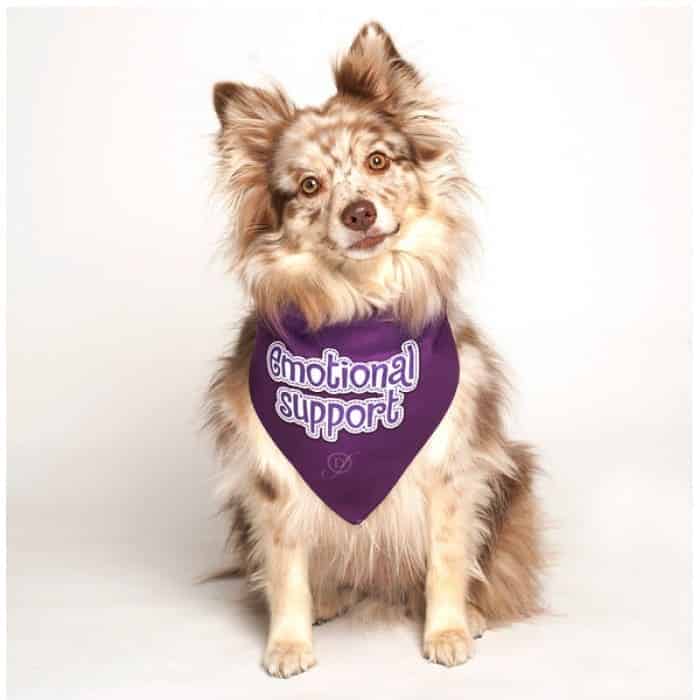Table of Contents
Do you sometimes feel alone and want your furry fellow to be with you? Emotional support dog training is just perfect for your dog to be your emotional support friend. Like guard dog training and dog board and train programs, emotional support dog training needs less training for your dog. However, you should know that there are several criteria that your dog needs to meet in order to become an emotional support animal. This article guide will cover the training for emotional support in detail to help you make your pet your best friend in times of distress. 
Emotional Support Animals ESAs
Emotional support animals, or ESAs, especially dogs, provide comfort and stability to those who are struggling with mental health issues. A dog owner usually needs a recommendation from an authorized mental health practitioner in order to be eligible for an emotional support animal. Teaching behaviors like deep pressure therapy (DPT), which reduces anxiety, is a part of emotional support training for dogs. Moreover, consulting with a professional trainer can improve the efficacy of training. ESAs may be allowed in homes and on flights, although not having the same legal rights as service animals. Other than ESAs, therapy dogs are trained to offer comfort in a variety of circumstances; they play different roles.

Benefits of Having an Emotional Support Dog
For those coping with mental health issues, having an emotional support dog has several advantages:
1. Emotional Support
An emotional support dog is a source of unwavering love and friendship that helps people in difficult situations.
2. Public Access
Emotional support dogs can accompany their owners in places where pets are normally prohibited with the appropriate paperwork, offering comfort and assistance away from the house.
3. Stress Reduction
Studies show that having an emotional support dog around lowers stress levels and encourages emotional stability and relaxation.
4. Teaching Opportunities
Moreover, owners can teach their dogs techniques like deep pressure therapy (DPT) that assist in regulating anxiety and offer comfort by enrolling them in emotional support training for dogs.
5. Physical Activity
Playing outside and going on walks with your dog promotes regular physical activity, which can lift your spirits and enhance your general well-being.
6. Social Interaction
Since emotional support dogs frequently start conversations or provide a point of connection with people, they can promote interaction with others and lessen feelings of isolation or loneliness.
7. Schedule and Routine
Having an emotional support dog fosters a sense of structure and routine that can be helpful for people dealing with issues related to their mental health.
8. Non-judgmental Support
moreover, Emotional support dogs provide their owners with non-judgmental support, enabling them to express themselves without worrying about being rejected or criticized.
9. Emotional Regulation
Having an emotional support dog around can help people manage their emotions and feel secure in stressful or anxiety-inducing circumstances.
10. Companionship
Above all, owning an emotional support dog offers a devoted and caring friend who is there to support, understand, and console you through the highs and lows of life.

Emotional Support Dog Training: Teach Your Dog to be Your Companion
Emotional support Dog training is a special method designed to get dogs ready to offer emotional stability, comfort, and companionship to people dealing with mental health issues. This is how it usually goes down:
1. Evaluation and Assessment: First Step in Emotional Support Dog Training
This initial phase entails determining whether the dog is a good fit for emotional support work based on its temperament and behavior. This guarantees that the dog possesses the appropriate traits and temperament to thrive in this ability.
2. Basic Obedience Training: Important Emotional Support Dog Training
Basic obedience commands and specific tasks like sit, stay, come, and leave form the basis of training emotional support dogs. The dog owner and dog build communication and control through these instructions.
3. Socialization in Emotional Support Dog Training
The third step in this training requires a socialization process. It is an essential component of emotional support dog training. Making sure the dog stays composed, self-assured, and well-behaved in all kinds of situations involves exposing them to a number of places, people, animals, and events.
4. Emotional Support Actions in Emotional Support Dog Training
Certain actions are taught to dogs with the goal of supporting their owners emotionally. This can entail giving a paw, offering to lean on their owner, giving deep pressure treatment (DPT), or just being there and paying attention when they’re in need. Moreover, teaching your dog these basic actions enables them to be a good companion.
5. Crisis Response Training
Certain emotional support dogs receive specific training from professional trainers that enables them to identify and react to their owners’ distressing or crisis-like behaviors. So, their training equips them to provide prompt assistance and comfort when required most.
6. Owner Education: An Important Step in How to Train an Emotional Support Dog
Owners are also taught how to identify stress or anxiety symptoms in their dogs, encourage desired behaviors, and provide the right kind of care and support to guarantee their well-being.
7. Regular Practice and Consistency
Your trained emotional support dog can bring you comfort and peace. However, success in any type of training depends on regular practice and consistency. To keep their dog’s skills throughout time and reinforce newly learned behaviors, owners must invest time and energy.
8. Legal Considerations
Under laws like the Fair Housing Act and the Air Carrier Access Act, owners of emotional support dogs are entitled to certain legal rights and obligations, including those regarding housing and travel accommodations.
The owner, the dog, and frequently a behaviorist or professional trainer work together to teach an emotional support dog. Emotional support dogs may significantly enhance the quality of life for those who are battling with mental health concerns through systematic training and continued assistance.

How to Train Your Dog for Deep Pressure Therapy (DPT)?
Deep pressure therapy (DPT) training entails teaching your dog specialized techniques for applying light pressure to your body in order to help reduce tension, anxiety, and sensory overload. This is how to prepare your dog for the DPT:
1. Foundation of Trust in Emotional Support Dog Training
Use positive reinforcement methods to build a solid bond and trust with your dog before beginning DPT training. Make sure your dog feels at ease and appreciates having physical touch with you.
2. Teaching the Behavior in Emotional Support Dog Training
Begin by teaching your dog to comfortably lie on your lap or next to you. Praise desired behavior with praise, treats, and mild prodding.
– While your dog is lying down, gradually introduce the idea of providing pressure by lightly pressing your palm against their body. Give them something to stay cool and collected.
– When applying light pressure, use a verbal cue like “pressure” or “squeeze” to help the subject correlate the action with the instruction.
– While making sure your dog stays at ease and content, gradually extend the time and force of the pressure.
3. Practice and Reinforcement
Regularly practice the DPT exercise in a peaceful, quiet setting where you and your dog are at ease.
– Every time your dog successfully presses in response to the command, reward them with treats, affection, or praise.
The secret is consistency. Repeat the training sessions regularly to reinforce the behavior and deepen your relationship with your dog.
4. Generalization in Emotional Support Dog Training
After your dog has learned DPT at home, practice the behavior in different settings to help it become more situational.
– When your dog exhibits DPT, encourage it to do so. As the behavior becomes more dependable, you should gradually wean your dog off of goodies.
5. Respect Your Dog’s Limits
During training sessions, pay attention to your dog’s cues and body language. If your dog exhibits any signs of discomfort or stress, stop training and gradually restart.
– Honor the boundaries and inclinations of your dog. Adopt an accepting and adaptable approach, as not every dog finds pleasure or success in dog training.
6. Consult a Professional Trainer for Emotional Support Dog Training
Take into consideration getting advice from a qualified dog trainer who is knowledgeable on DPT training methods. They can offer customized guidance and support based on your dog’s requirements and personality.
Deep pressure treatment training for dogs calls for dedication, consistency, and positive reward. Your dog can learn to offer soothing pressure and support during stressful or anxious times with time and practice, which will be advantageous to both you and your pet.
Emotional Support Dog Training for Anxiety
If the dog owner has anxiety and needs an emotional support companion, the dog has the ability to do that. Your dog just needs to follow the training program specialized for anxiety. An organized method that is tailored to the needs of the individual is needed when training an emotional support dog to help with anxiety. Here’s how to train a dog that will help you emotionally:
1. Basic Obedience: Emotional Support Dog Training Program
To develop control and communication, begin with basic obedience training. Use positive reinforcement tactics to teach commands like come, sit, and stay.
2. Desensitization and Counterconditioning in Emotional Support Dog Training
To change the dog’s emotional response, progressively expose them to anxiety-inducing circumstances while associating them with pleasurable activities, such as playtime or goodies.
3. Calm Behavior Reinforcement
To promote emotional stability, praise for calm, collected behavior is provided. Treats, compliments, or toys can help the dog stay composed under stressful circumstances.
4. Deep Pressure Therapy (DPT) in Emotional Support Dog Training
When the dog senses anxiety, teach him or her to apply deep pressure by lying down or leaning on the person. This may provide one with a feeling of security and comfort.
5. Identifying Anxiety Signs in Emotional Support Dog Training
Teach the dog to recognize the owner’s anxious behaviors, such as pacing or breathing difficulties. Show them how to reply by being nearby or interacting gently while providing comfort and support.
6. Create Safe Spaces: An Important Part of Emotional Support Dog Training
Set aside specific areas where the dog can hide when its owner is feeling nervous. Provide cozy bedding and toys in these areas to encourage rest.
Additionally, think about getting the help of a professional trainer with training experience in emotional support dogs. In addition to offering direction and knowledge, they can customize a training program to target certain anxiety triggers and habits. Furthermore, keep in mind that emotional support animals (ESAs) are permitted to travel with their owners in housing and on airplanes due to legal protections provided by the Fair Housing Act and the Air Carrier Access Act.
However, if you want to know more about emotional support dogs, such as how to qualify for such dogs, check out this blog here.

Perfect Breeds for Emotional Support Dog Training
Numerous dog breeds are well-known for their loving nature, devotion, and gentle disposition, which makes them ideal for the function of emotional support dogs. Some breeds that are frequently acknowledged as suitable contenders are:
1. Labrador Retriever
Labradors are gregarious, extroverted, and incredibly trainable. They are wonderful emotional support companions because of their kind disposition and strong bonding capacity with their owners.
2. Golden Retriever
Famous for their kind and amiable nature, Golden Retrievers are similar to Labrador Retrievers. They are excellent at offering emotional support because they are understanding, flexible, and eager to please.
3. Poodle
Available in three sizes (standard, miniature, and toy), poodles are smart, hypoallergenic, and adaptable canines. They are well renowned for being trainable and are great companions for anyone with allergies or sensitivity issues.
4. Cavalier King Charles Spaniel
These are kind, friendly, and loyal canines. They are excellent at supporting their owners emotionally and thrive on human company.
5. Bichon Frise
Known for their playful nature and hypoallergenic coat, Bichon Frises are gregarious, friendly, and happy dogs. They develop close relationships with their owners and are excellent companions and emotional support animals.
6. French Bulldog
French Bulldogs have a calm disposition and are devoted, loving, and adaptive canines. Even though they are small, they have big personalities and are frequently called “clowns,” which makes their owners happy and comfortable.
7. Cocker Spaniel
Cocker Spaniels are renowned for their loving character, mild temperament, and gentle demeanor. They are great emotional support companions since they love being near their owners and thrive on attention.
8. German Shepherd
German Shepherds are excellent as emotional support animals, despite being mostly recognized for their work as working or service dogs. They build close relationships with their owners and are perceptive, devoted, and protective animals.
When choosing an emotional support dog, it’s important to remember that temperament and personality traits unique to each owner matter more than breed. Any breed or combination of dogs, given the proper temperament, training, and owner-dog attachment, can offer emotional support.

Personality Traits of an Emotional Support Dog
A number of characteristics make an emotional support dog a good fit for their job:
1. Empathy
Emotional support dogs are highly sensitive to their owner’s feelings and can react in a way that shows understanding and empathy.
2. Calm Temperament
They have an innately calm manner that helps ease their owner’s tension or anxiety.
3. Affectionate Nature
Most emotional support dogs are loving and like to have close physical touch with their owners, giving them comfort by rubbing or cuddling.
4. Adaptability
They can adjust to different settings and circumstances while maintaining their calmness and attention to their owner’s demands.
5. Stability
Emotional support dogs give their owners a sense of continuity and stability by supporting them resolutely through trying circumstances
6. Intuition
They are able to figure out their owner’s emotional state intuitively and frequently provide comfort before symptoms of discomfort show themselves.
7. Non-judgmental
Providers of unconditional love, acceptance, and emotional support dogs foster a non-judgmental environment in which their owners can freely express themselves.
8. Bonding Ability
They establish enduring relationships of trust and companionship, creating a profound and significant connection with their owner.
9. Reliability
Emotional support dogs are dependable in offering comfort and help on a regular basis, making life easier for their owners.
10. Responsive
They can learn specialized actions, like deep pressure treatment or recognizing anxiety signals, to better support their owner’s emotional needs. They are very responsive to instruction.
All of these traits combine to make emotional support dogs great friends for people dealing with mental health issues, offering emotional stability, comfort, and unconditional love just when it’s required.

Difference Between Service Dogs, Therapy Dogs, And Emotional Support Dogs
The duties, training, and legal safeguards that set service dogs, therapy dogs, and emotional support dogs apart are as follows:
1. Service Dogs
Role: Trained to carry out particular duties to support people with disabilities. These activities assist in reducing the consequences of the person’s disability and are directly tied to it. Examples include giving directions to blind people, warning deaf people of sounds, and supporting those with mobility problems.
Training: Service dogs go through an intense training regimen to acquire specialized skills that satisfy the demands of their owner. This training might take months or years to finish and is frequently customized to the individual’s unique disabilities.
Legal Protections: Regardless of pet regulations, service dogs are permitted to accompany their handlers in public settings such as restaurants, shops, and public transit because they are granted legal protections under the Americans with Disabilities Act (ADA).
2. Therapy Dogs
Role: Trained to offer comfort, affection, and emotional support to individuals in a variety of situations, including medical facilities, care homes, educational institutions, and disaster relief situations. Instead of performing specialized duties associated with a person’s condition, they engage with a variety of people to offer consolation and assistance.
Training: Therapy dogs go through training to acquire social skills, manners, and a temperament that makes them suitable for engaging with a variety of people. Their certification is frequently obtained from therapy dog organizations, and they are required to be well-mannered, composed, and pleasant.
Legal Protections: Unlike service dogs, therapy dogs are not as protected by the law. The organization or facility they are visiting usually allows them access to public areas on an individual basis.
3. Emotional Support Dogs
Role: Emotional support dogs offer emotional stability, comfort, and companionship to people suffering from mental health issues. Rather than carrying out certain disability-related duties, they provide support by being there and being friends.
Training: Although they can receive basic obedience training, emotional support dogs do not need specific training in order to carry out tasks. Instead, their owners find that their very presence is soothing.
Legal Protection: Laws like the Fair Housing Act (FHA) and the Air Carrier Access Act (ACAA), which provide housing and travel accommodations, respectively, provide protection for emotional support dogs. They are typically not permitted in public areas where pets are not permitted, and they do not have the same rights of access as assistance dogs.
To summarize the differences, therapy dogs bring comfort to people in a variety of contexts, emotional support dogs provide companionship and emotional support to persons with mental health disorders, and service dogs are taught to carry out specific tasks for people with impairments. Every kind of support animal has a unique purpose, distinct training needs, and unique legal protections.
Conclusion
To wrap up, the article covered detailed information on emotional support dog training, the steps, and much more. Moreover, the basic differences between therapy dogs, service dogs, and emotional support dogs have also been mentioned. So, stop worrying if you are mentally upset, and get yourself a furry fellow.
Stress-Relief Partner!


